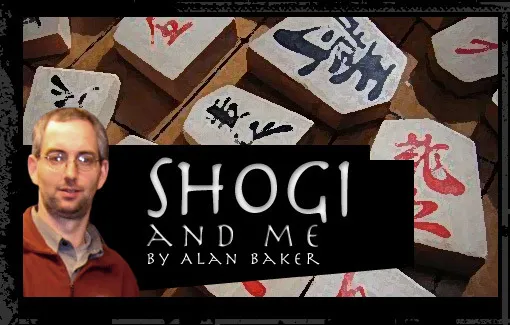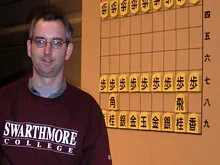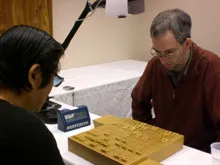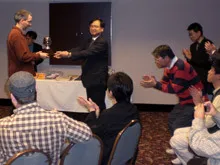Shogi and Me

Associate Professor of Philosophy Alan Baker joined Swarthmore's faculty in 2003. Specializing in the philosophy of mathematics and the philosophy of science, his courses also include logic and philosophy of mind. During the summer of 2006, he served as "philosopher in residence" at Whitehall, the 18th-century home of philosopher George Berkeley near Newport, Rhode Island. Write to him at abaker1@swarthmore.edu.
This spring, Alan Baker won the 13th Annual U.S. Shogi Championship, a feat which will take him to Yamagata, Japan, in November for the triennial International Shogi Festival, featuring 41 players from 28 different countries.
Shogi is a distant cousin of western chess - they both trace their origins back to the ancient Indian game of chaturanga. The game looks very different from chess since shogi pieces are all the same flat shape and are covered with Chinese calligraphy. However, the aim is the same as chess - to checkmate the opposing king. In addition to the king, shogi has other pieces in common with chess (rook, bishop, knight), while also having some distinctive pieces of its own (lance, gold general, silver general). The most important difference between shogi and chess is that captured shogi pieces can return to the fray. When you capture an opposing piece you keep it beside the board and have the option of 'dropping' it back into play on any empty square as one of your own pieces. The effect of this difference is to make shogi a much more tactically aggressive game than chess.
I used to play a lot of western chess. On a trip to Japan in 1996, I discovered the Japanese version of the game. I was due to take a 36-hour ferry journey from Tokyo to the southern island of Kyushu, so I bought a portable shogi set. I spent most of the ferry trip playing shogi - very badly - with the English friend who was traveling with me, much to the amusement of our fellow passengers! I have played shogi ever since, at clubs and tournaments, but also online, and I estimate that I've played about 2,500 games over the past 10 years. In the process, I've gradually moved into the ranks of the top handful of American shogi players.

Members of the shogi club Alan founded at Swarthmore hope to expand the game's popularity so they can establish an inter-collegiate club.
There are estimated to be around 20 million shogi players in Japan. Shogi's popularity outside Japan has been increasing in recent years, but it remains very much a minority pursuit. There are a few active shogi clubs in the U.S. - in New York, Chicago, Los Angeles, and San Francisco. Most western chess players who learn shogi end up thinking that shogi is the superior game, but it does take some time and effort to overcome the initial barrier of learning the new moves and symbols for the shogi pieces.
At Swarthmore, I founded the Shogi Club in 2005, and we meet weekly during the semester. It is currently the only college-based shogi club in the country. The number of students attending fluctuates from week to week, but there is now a core of around a dozen players who have achieved a respectable standard, and probably between 20 and 30 more who have learned the basics of shogi. The quirky nature of shogi and the intellectual challenge it provides seems to appeal to Swarthmore students. The club has also benefitted from the strong Japanese studies progam at the College. I hope to bring students with me to future U.S. shogi tournaments.
In March, I participated in the 13th U.S. Shogi Championships in Chicago. Of the 32 players in the main event, about three-quarters were either Japanese or of Japanese descent. There were also four professional shogi players from Japan in attendance whose role was to give shogi lessons, play instructional games, and provide commentary on some of the tournament games. I don't speak any Japanese myself, so a lot of the comments being bandied around during and after the games went straight over my head.

Alan, a 2 Dan, played Mark Ohno, a 4 Dan from Los Angeles, in the championship's final round.
Shogi players are assigned ratings based on their previous performances, so you can get a sense in advance of how strong your opponent is likely to be. My own rating placed me somewhere in the middle of the 32-player field, so I was definitely not one of the favorites to win. There is always a feeling of pressure at these tournaments because the format is a knockout. So a single bad move can be enough to eliminate you from the competition!
By the Sunday afternoon it was down to just two competitors - myself and Mark Ohno, an experienced player and one of the strongest members of the Los Angeles shogi club. We played the final game in a separate room that was linked by a live video feed to the main auditorium, where two of the pros gave play-by-play commentary. One of the professionals acted as scorekeeper, recording our moves as they were played. I think we were both nervous before the game started; neither of us had been in a final before, and we did not want to do something stupid with such a large audience watching.
But as soon as we started playing, my nerves melted away. I quickly became immersed in the intensity of the game itself, concentrating on my next move and on the possible replies for my opponent. Despite the main auditorium being separated from us by two closed doors and a long corridor, I could hear occasional shouts, and roars of laughter from the audience. Clearly the pros were providing some entertaining commentary for the crowd!

By winning, Alan will represent the U.S. when he competes in Yamagata, Japan, for the world championship.
It turned out to be an exciting game, and we each had chances to win at different stages. I came out of the opening worse, but managed to even things up in the middlegame. As is often the case with shogi, the endgame developed into a tactical battle with each of us relentlessly pursuing the other's king. After almost two hours of play, the tide was turning in my favor. With his king almost cornered, my opponent's hand hovered over a square with a pawn ready to be dropped in defense. Somehow he had not seen that this move would be illegal, and in shogi an illegal move immediately loses the game.
As I waited for a move to be played I heard a muffled roar from the distant audience. Up on their video screen they must have seen Mark Ohno's hand poised to make the illegal move, and they reacted accordingly. I cursed inwardly. Surely the hubbub would alert Mark to the error he was about to make. He paused for a couple more seconds, withdrew his hand and then dropped the pawn on a different square. But this was an illegal move, too! Luck was on my side. He had lost the game and I had won the title of U.S. Shogi Champion.



